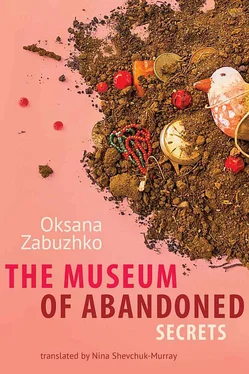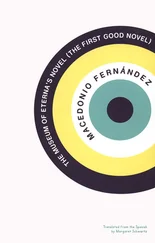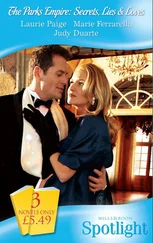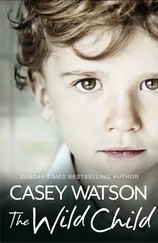Oksana Zabuzhko
THE MUSEUM OF ABANDONED SECRETS
Translated by Nina Shevchuk-Murray
Regardless of their original functions, objects buried for an extended time underground or under water become archeological artifacts. At the moment they are recovered, their new history begins. Being buried underground often results in damage … to both organic and inorganic materials…. The goal of preventative conservation is to arrest the progress of such destruction by ensuring optimal storage conditions.
—From “Cultural Welfare: Restoration of Archeological Finds in Berlin’s State Museums,” exhibit guide, Altes Museum, Berlin, March 27–June 1, 2009
To know what’s happened to us… wait for us.
—A 1952 inscription on a wall of the Lviv KGB prison, open to the public since 2009 as the Lontsky Street Prison Museum
The Museum of Abandoned Secrets Family Tree

And then come the photos: black and white, faded into a caramel-brown sepia, some printed on that old dense paper with the embossed dappling and white scalloped edges like the lace collars of school uniforms, all from the pre-Kodak era—the era of the Cold War and nationally manufactured photography supplies (really, nationally manufactured everything)—and yet, the women in the pictures are adorned with the towering mousses of chignons, those stupid constructions of dead and, more often than not, someone else’s (ugh) hair. They are dressed in the same stiff rectangular dresses as the ladies in a Warhol film or, as say, Anouk Aimée in 8½ (a film they could have actually seen, or at least had a theoretical chance of seeing, if they endured the five-hour wait in the squeeze of the film-festival crowd, then fought their way into the movie hall, sweaty and ecstatic, with those chignons knocked askew and with dark multicolored horseshoes of sweat in the armpits of the white nylon blouses that one always wore with one’s best colored chemises—nationally manufactured, naturally—cerulean, pink, lilac).
But the photos can’t show you the chemises or the moist horseshoes, nor could anyone reproduce the smell of those lines—of bodies still naïve to deodorant, but generously floured with powder and rouge and scented with Indian Sandalwood from the Red Moscow factory or, at best, though no less cloying, with the Polish-made May Be. No one could ever restore that mottled chorus of perfume and the women’s hot flesh, and in the pictures—freshly made-up and with their hair just so—the women could easily pass for Anouk Aimée’s contemporaries with no Iron Curtain visible from where I stand forty years later.
You know what I just thought? Women are generally less susceptible to political perturbations than men. They pull on their nylon stockings, or later, the hose that were so hard to find in the stores, and smooth them over their legs with the same concentration no matter what—Kennedy assassinations or tanks in the streets of Prague—and that’s why it is men who truly define the face of a country (at least the country we once had).
Do you remember the hats the men wore? Those identical furry cubes with earflaps, same for all, like a uniform. Pyzhyk. That’s what the fur was called, that’s right, herds of silently black pyzhyks lined up in military precision on the terrace of Lenin’s Mausoleum on the 7th of November, and it was invariably pouring—as if the whole universe were in mourning—while stressed-out column organizers barked at the marchers like guard dogs at chain gangs because the columns were to pass in front of the mausoleum without umbrellas, bareheaded in the rain or snow, so as not to spoil the picture on TV (not that we had color TVs, our national manufacturers hadn’t quite “overtaken” the West on that front yet).
But you protest. Those had come around by the seventies, except they were impossible to find and expensive as hell.
Alright, what’s next? This stern-faced rug rat in a romper with pom-poms, that’s you, too? And the woman holding you on her lap, who’s that? Granny Lina? The picture casts a spell—grips you and doesn’t let go—maybe because just as the photographer closed the shutter, the woman lowered her eyes to the baby with that preoccupied and beatific expression that all women have when they hold a child—theirs or someone else’s—leaving us on this side of the lens, waiting for her to look up again, while the picture grows more disconcerting the longer you look, especially when you know that the woman is long gone from this world, and we will never know what she would’ve looked like had she blinked and raised her eyes from the baby that instant.
As if I didn’t have plenty of my own ghosts—my own unfading, caramel-shiny brown faces, dappled with the pox of the same raster that cannot be Photoshopped away. Pictures that when scanned lose their soul—like poems translated from one language to another—looking dreadfully pitiful on screen, as if they’d been pulled out of the water and hung to dry on an invisible wire. Raised from the bottom of the sea, one could say, the phrase calling up a subconscious habit of perception: there they were, buried under silt and water, and we found them and brought them back to light—like it’s some great favor or something. Where exactly does it come from, I’d like to know, this ineradicable attitude of superiority toward the past? This stubbornly dumb, can’t-kill-it-with-an-ax conviction that we, the now, critically and categorically know better than they, the past. Is it from the mere fact that their future is known to us, that we know what happens? (Nothing good.) It’s much the way we treat small children—pedantic and permissive at the same time. And we always think of the people of the past—just as we do of children—as being naïve in everything from their clothes and hairstyles to their thoughts and feelings. Even when those people are our own family. Or rather, had been, once.
“What are you thinking about?”
“I don’t know. Us, I guess.”
This is the difference between a marriage and all other (however volcanically eruptive) affairs and flings—this obligatory exchange of ghosts. Your dead become mine and vice versa. The list of names submitted for All Souls’ Mass grows longer: as always, there is Anatoly, Lyudmyla, Odarka, Oleksander, Fedir, and Tetyana, but after them come, like a new orchestra section joining a symphony in a drawn-out, lowering, celloed, and double-bassed andante, Apollinaria, Stefania, Ambroziy, Volodymyra—names that sound as if they belonged to a completely different nation, and maybe it was a different nation after all, the one wiped out in 1933 between Kyiv and Poltava—a tribe whose members have names like Thalimon or Lampia or Porf or Thekla, names that make one think of early Christians and not at all of relatives and kin just two or three generations removed. The Western, Galician, Catholic names from the same time sound alive in comparison, however vaguely—but still there are people who can say, that’s my uncle, that’s my grandpa, that one perished in Siberia, and this one emigrated to Canada.
That’s when you recall, with an addled nostalgic smile that spreads on your face slowly, out-of-focus—like milk spilled on a table—how one day in the early eighties a box came for your family from Canada, from just such a brother-of-a-third-cousin-once-removed uncle. The KGB let it through somehow, either because it was already busy packing up or just plain and simple had lost its grip, like everything in this country that turned loose and flabby right before the finale. A real Canadian box containing no flower-rimmed, square shawl that the diaspora insisted on supplying in great numbers to the Old Country but jeans —sweet Jesus!—your very first Levi’s, and a denim shirt to go along, and then in the foreign-currency-only Beryozka store your parents bought you real Adidas sneakers and an Adidas backpack, and that’s how you arrived at school, every day.
Читать дальше
